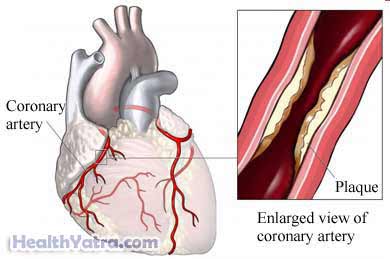Definition
Coronary arteries bring oxygen rich blood to the heart muscle. Coronary artery disease (CAD) is blockage of these arteries. If the blockage is complete, areas of the heart muscle may be damaged. In a severe case, the heart muscle dies. This can lead to a heart attack, also known as a myocardial infarction (MI).
Coronary artery disease is the most common form of heart disease. It is the leading cause of death worldwide.

Causes
Causes include:
- Thickening of the walls of the arteries that feed the heart muscle
- Build up of fatty plaques within the coronary arteries
- Sudden spasm of a coronary artery
- Narrowing of the coronary arteries
- Inflammation within the coronary arteries
- Development of a blood clot within the coronary arteries that blocks blood flow
Risk Factors
Major risk factors include:
- Sex: male—men have a greater risk of heart attack than women
- Age: 45 and older for men, 55 and older for women
- Heredity: strong family history of heart disease
- Obesity and being overweight
- Smoking
- High blood pressure
- Inactive lifestyle
- High cholesterol, specifically, high LDL cholesterol and low HDL cholesterol
- Diabetes
- Metabolic syndrome —a combination of high blood pressure, abdominal obesity, and insulin resistance
Other risk factors may include:
- Stress
- Excessive alcohol use
- Depression
- A diet that is high in saturated fat, trans fat, cholesterol, and/or calories—Drinking sugary beverages on a regular basis may increase your risk of CAD.
Symptoms
CAD may progress without any symptoms.
Angina is chest pain that comes and goes. It often has a squeezing or pressure-like quality. It may radiate into the shoulder(s), arm(s), or jaw. Angina usually lasts for about 2-10 minutes. It is often relieved with rest. Angina can be triggered by:
- Exercise or exertion
- Emotional stress
- Cold weather
- A large meal
Chest pain may indicate more serious unstable angina or a heart attack if it includes the following:
- It is unrelieved by rest or nitroglycerin
- Severe angina
- Angina that begins at rest
- Angina that lasts more than 15 minutes
Accompanying symptoms may include:
- Shortness of breath
- Sweating
- Nausea
- Weakness
Immediate medical attention is needed for unstable angina. CAD in women may not cause typical symptoms. It is likely to start with shortness of breath and fatigue.
Diagnosis
If you go to the emergency room with chest pain, some tests will be done right away. The tests will attempt to see if you are having angina or a heart attack. If you have a stable pattern of angina, other tests may be done to determine the severity of your disease.
The doctor will ask about your symptoms and medical history. A physical exam will be done.
Tests may include:
- You may need to have your bodily fluids tested. This can be done with blood tests.
- You may need to have your heart function tested. This can be done with:
- Electrocardiogram
- Exercise stress test
- Nuclear stress test
- You may need to have pictures taken of your heart. This can be done with:
- Echocardiogram
- Coronary calcium scoring—a type of x-ray called a CAT scan
- Coronary angiography
Treatment
Treatment may include:
Nitroglycerin
This medicine is usually given during an attack of angina. It can be given as a tablet that dissolves under the tongue or as a spray. Longer-lasting types can be used to prevent angina before an activity known to cause it. These may be given as pills or applied as patches or ointments.
Blood-Thinning Medications
A small, daily dose of aspirin has been shown to decrease the risk of heart attack. Ask your doctor before taking aspirin daily.
Other blood-thinning medicines include:
- Warfarin (Coumadin)
- Ticlopidine (Ticlid)
- Clopidogrel (Plavix)
- Prasugrel (Effient)
Beta-Blockers, Calcium-Channel Blockers, and ACE-Inhibitors
These may help prevent angina. In some cases, they may lower the risk of heart attack.
Medications to Lower Cholesterol
Medicines, like statins, are often prescribed to people who have CAD. Statins lower cholesterol levels, which can help to prevent CAD events.
Revascularization
Patients with severe blockages in their coronary arteries may benefit from procedures to immediately improve blood flow to the heart muscle:
- Percutaneous coronary interventions (PCI)—such as balloon angioplasty, in some cases, a wire mesh stent is placed to hold the artery open
- Coronary artery bypass grafting (CABG)—segments of vessels are taken from other areas of the body and are sewn into the heart arteries to reroute blood flow around blockages
Options for Refractory Angina
For patients who are not candidates for revascularization procedures, but have continued angina despite medicine, options include:
- Enhanced external counterpulsation (EECP)—large air bags are inflated around the legs in tune with the heart beat. The patient receives 5 one-hour treatments per week for seven weeks. This has been shown to reduce angina and may improve symptom-free exercise duration.
- Transmyocardial revascularization (TMR)—surgical procedure done with laser to reduce chest pain
Prevention
To reduce your risk of getting coronary artery disease:
- Maintain a healthy weight.
- Eat a heart healthy diet that is low in saturated fat, red meat and processed meats, and rich in whole grains, fruits, and vegetables.
- Begin a safe exercise program with the advice of your doctor.
- If you smoke, quit.
- Treat your high blood pressure and/or diabetes.
- Treat high cholesterol or triglycerides.
- Ask your doctor about taking a low-dose aspirin every day.
- In certain patients, taking medication to treat high cholesterol may be another option. Talk to your doctor.
- Find ways to reduce stress.
